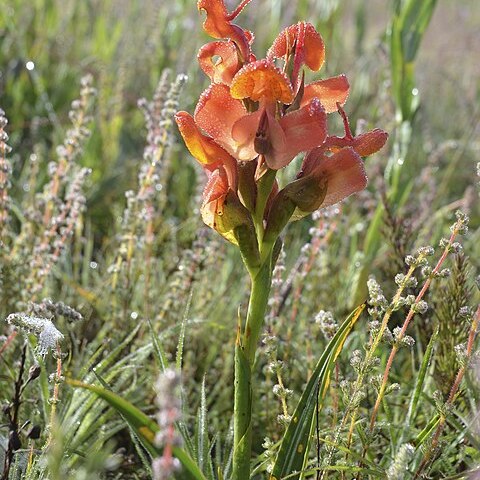An orchid that grows in the ground. It grows 90 cm high. It has slender tubers 3 cm long by 1.5 cm wide. There are leaves on separate non flowering shoots and these are narrow and 30 cm long. The leaves on the flowering shoots aee sword shaped and 3-8 cm long. The flowering stalk can be 19 cm long. There are 3-10 flowers. They are arranged loosely. They are orange or red.
Petals 2-lobed; anterior lobe 7–15 mm long, ovate, flanking the anther, spreading; posterior lobe 20–35 mm long, linear, ascending inside the galea, parallel in the lower half, then diverging by an S-shaped curve.
Dorsal sepal spathulate; claw erect, 11–26 × 3–7 mm, canaliculate; blade 12–20 mm long, ovate-elliptic, acute, galea 3–5 mm deep, facing downwards.
Fertile shoots 40–90 cm tall; leaves imbricate, 3–8 cm long, lanceolate, acute, sheathing, only the apices free.
Sterile shoots to 12 cm long; leaves 2–3, conduplicate, to 30 × 2 cm, linear, acute, erect.
Spur ascending from shortly below the middle of the blade, slender, 8–16 mm long.
Leaves on separate barren shoots linear or narrowly lanceolate, 6-18 in. long
Floral bracts c. 3 cm long, lanceolate, acute, reaching up to the flowers.
Flowers orange, flame-coloured or deep red, spotted in parts
Terrestrial herb with separate fertile and sterile shoots.
Spike about 2-6 in. long, rather lax, 3-10-flowered
Inflorescence lax, 5–13 cm long, 1–6(12)-flowered.
Stigma sessile, tripulvinate, 3–4 mm in diameter.
Lip pendent, 9–20 mm long, linear.
A terrestrial herb 1-3 ft. high
Anther erect, 5–8 mm long.
The lower sheaths spotted
Rostellum 2 mm long.
Ovary c. 2 cm long.
Flowers bright red.


